January was a difficult one. It rained almost continuously for the first half of the month until we were experiencing what in recent years has become the all too familiar collection of winter flood reports. Apart from countless localised problems, the lower part of Crickhowell went under water, property was flooded in places like Glasbury and Hereford, the main Gloucester to Chepstow rail line was closed several times by landslips and as usual roads were closed and houses flooded in the low-lying Severn Vale in the area of Tewkesbury and Upton. Sheets of standing water were visible in fields everywhere. People imagine that chalk streams are protected against such fluctuations of level, but it isn’t altogether true. Keeper Peter Major sent us some film from Heale on the Wiltshire Avon, where the water had spread across the meadows of the valley floor from the main river to connect it with the carriers and even covered the access road to the fishery in a wide lake. Then everything changed as new winds brought high pressure and icy temperatures from the north. During a ten day period of hard frosts when the temperature rarely rose above freezing, the river levels began to fall, but quite slowly, as we approached the month’s end.
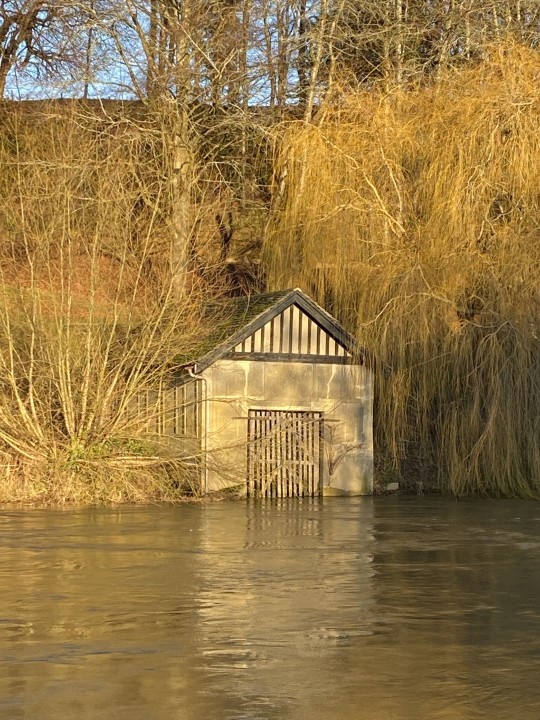 Lower Canon Bridge - ME from Ireland
Lower Canon Bridge - ME from Ireland 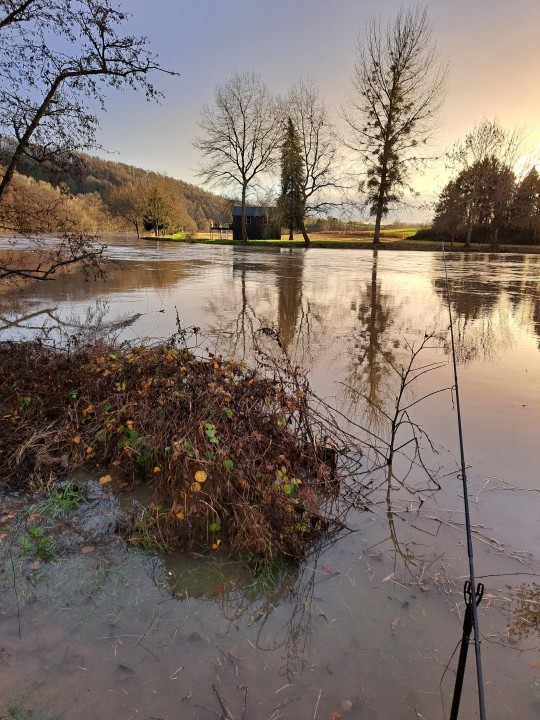 River breaking its banks - GB from Bristol
River breaking its banks - GB from Bristol I received the Christmas holiday reports to read, but I’m afraid this time there wasn’t much successful fishing for any of us to crow about. Without exception, all our rivers were by then in proper flood, so that it was an act almost of faith to try to fish them except perhaps with bait. Still, people had holidays booked and I have to applaud those who tried. BW from Stratford on Avon who fished Court of Noke on 20th December criticised what he called “terrible access” on what he has decided is his least favourite wild stream. That seemed a little harsh to me; Court of Noke is certainly a bit wild, but I think access would have been easier had it not been in flood and there might have been opportunities with the trotting rod. CM from Lutterworth had 14 grayling by trotting the Lugg at Eyton on the same day, this being the only really successful grayling catch of the Christmas period. GM from Lutterworth later in January had 6 grayling trotting with a centre pin at Eyton, in what he described as the only fishable swim, with the Byton level right up at 0.77 metres. JP from Swell with a friend visited the Monnow at Skenfrith with a view to fishing nymphs and understandably gave it up as “unfishable.” Coarse anglers on the Wye were doing slightly better with most people reporting a few chub, some of them big ones, and there was also the occasional barbel. The main limiting factor here was snow-melt water coming down the river and water temperatures at times were as low as 5 degrees. I don’t think snow-melt water helps any kind of fishing.
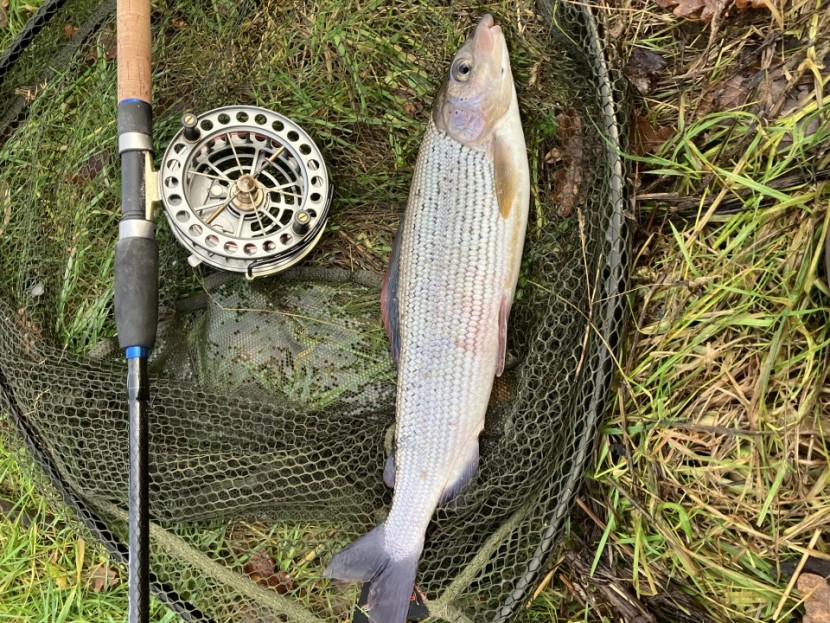 Lugg grayling and Youngs centrepin - GM from Lutterworth
Lugg grayling and Youngs centrepin - GM from Lutterworth 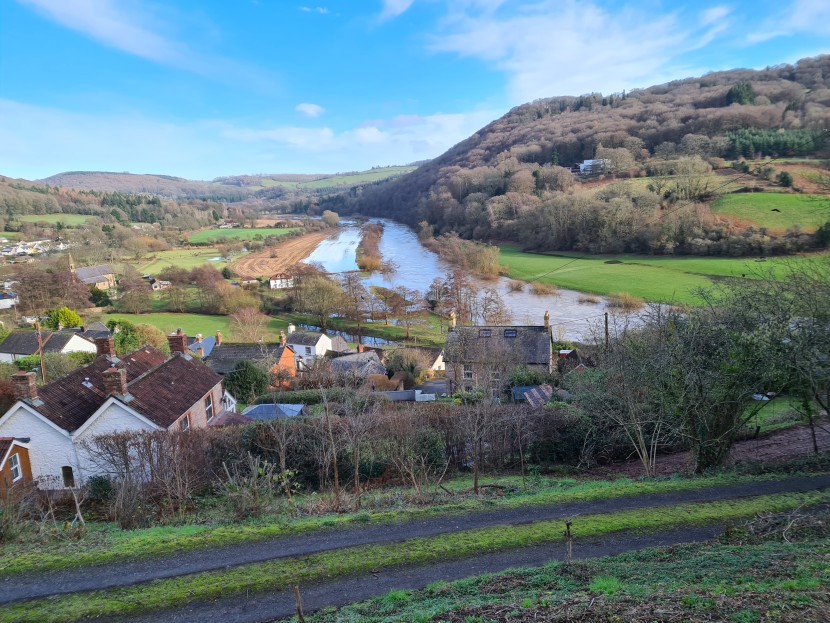 Wye flooding at Llandogo
Wye flooding at Llandogo Some game fishing on the upper parts of the Wye and certain tributaries was able to restart by the 20th January. The water was high but clear and the air temperature still very cold. MH from Llandrindod Wells had one of his regular winter trotting sessions on the GPAIAC water at Builth Wells and caught 29 grayling, mostly over a pound. He was back on the 23rd when he caught 26 grayling plus a couple of chub, leaving off only when the unseasonable trout began to move in. MH from Swansea was fishing with heavy nymphs at Gromaine and Upper Llanstephan on the same day and caught 5 grayling during a brief spell of activity in the middle of the day. GM from Lutterworth also had 5 grayling while fishing the Lugg at Eyton on the 26th. DW from Caernafon with a friend had 14 grayling from the Dee at Llangollen Maelor. Coarse fishermen continued to catch the odd chub and pike from the lower part of the main Wye. RE from Cwmbran fished at How Caple Court on the 29th without result and even claimed to have been sunburnt! Or was it possibly wind burned? Grayling catches were generally modest, even as river conditions began to look quite good by the end of the month.
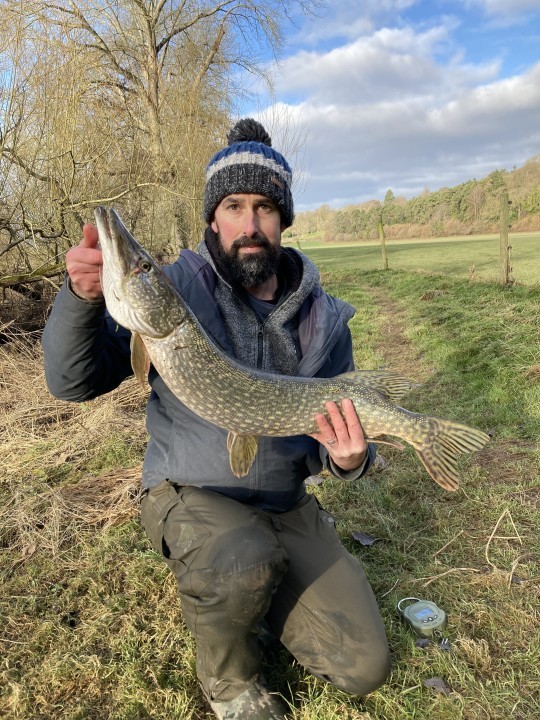 Wye pike - BA from Epsom
Wye pike - BA from Epsom 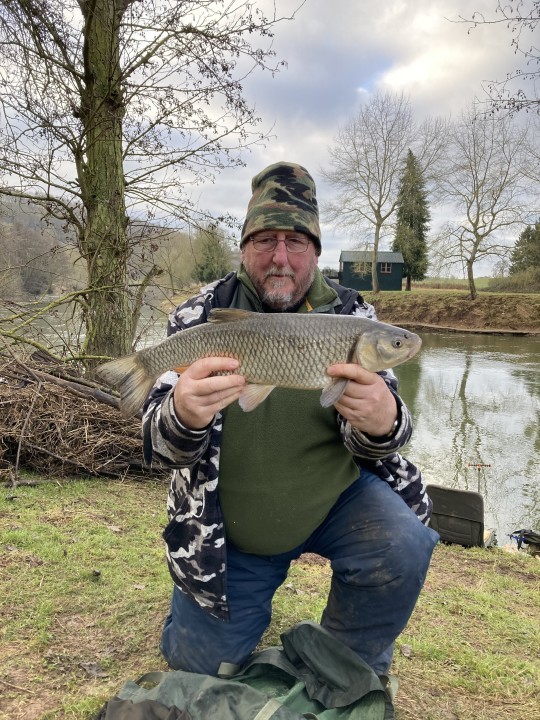 How Caple Court - BA from Epsom
How Caple Court - BA from Epsom A few people sighted otters during the floods. The nocturnal otter tends to be more universally present than most of us realise, unless of course we deliberately look for footprints or fish at night. In flood water, however, otters tend to fish by day and I think they do very well searching under the banks and through the slacks for fish sheltering from the current. On a high water day in the Wye you will glimpse an otter turning over at the surface at times almost like a salmon rolling. Locally in the Forest of Dean the otter’s presence has been rather less obvious. We have known for many years that otters sometimes access the little streams draining the Forest dome, but they are rarely seen. The evidence has been confined to foot prints and the occasional night time road kill. By torchlight I was once even shown otter footprints in the wet mud of a free mine’s drainage adit, this place being far underground and hundreds of yards uphill from the outlet to Cannop Ponds. How – and why – do they find their way up there in the pitch blackness?
 Otters on the road
Otters on the road Recently the otter’s presence in the Soudley Brook, the Forest stream which has lately had so much attention due to the crayfish plague, has become more generally known, especially to the various ecology organisations. I do wonder in fact if the problems with the crayfish disease might have something to do with the otter, which dines on crayfish and ranges widely. Natural England has even gone so far as to put up a sign for motorists warning of otters crossing the road on their way past the dam between Upper and Lower Soudley villages. Otters have certainly found their way to our Forest Pool and its stock of rainbow trout. Our Secretary walked round the other day and found the remains of a meal with all the unmistakable signs. On the mud bank at the head of the pool lay what had been a 5 pounds rainbow, with the front half quite eaten away and a trail of scales with a little blood. Not too much doubt about that, we concluded. Later we found the mud-slide where the otter makes his way over the dam. Nor is there much we can do about it; we would not be allowed to erect an electric fence on crown property with public access even if we could organise it.
It’s a difficult business, defending a stocked fishery, whether on private or public land. Most of the time we just grit our teeth and bite the bullet. There are predators everywhere. For very good reasons I tend to fish the pool early, not long after dawn, and then, before other anglers and walkers arrive, is when I tend to see my piscivorous friends. The family group of kingfishers are always there: electric blue flashes between the willows and alders at the top end. They eat mainly sticklebacks and nobody minds them. It’s similar with lesser grebes or dabchicks which are more common on the pond than they used to be. I dare say that when they dive they do some damage to the fry and smaller roach, but this is only competition for available food rather than any kind of direct attack on our stock fish. It’s the same for the heron who is almost always present standing in the shallows at the top end. He usually takes off when I approach (although herons are less shy than they used to be) and retires to a high perch in the fir trees above the pool. The heron is another consumer of small fish although he might do some damage to the native brown trout. I’m less happy about the groups of goosanders sometimes present in winter. A band of 30 of them were on the pond the other morning. Our big stock fish are probably too much for them but they are very efficient raiders with their in-line herding tactics. Goosanders are definitely shy and they usually leave when anybody appears. Currently we are being troubled by a solitary cormorant and I’m a lot less happy about him. He spent the summer as an adolescent living on one of the upper pools which we do not now rent, probably consuming the native roach. You could see him most days, sitting out on the skeletal branch of a tree fallen in the water. Now he is an adult, has taken to visiting the lower, stocked pool, and I know full well that he can manage any size of fish up to 2 pounds. I think I can tell when he has been quartering the pond underwater; the fish somehow act spooked and nervous just as they might after a long period of casting over them. Right now he takes off when I shout and clap my hands, but I know he will be back and there is nothing legal I can do to prevent it.
Otters are the latest arrival and we have to recognise that a family of otters can do us a lot of damage if they decide to stay. Personally I can live with it, because logically or otherwise, I’m fond of otters. Maybe we will have to recognise the situation that we are buying fish for these beautiful animals as well as ourselves. Otter hunting along with other kinds of hunting with more than two hounds was made illegal a few years ago. In fact, as most people who live in the countryside get to realise, hunting of various kinds continues, mainly under the guise of drag hunting, while the police pointedly look the other way. My own view in principle is that having a law in existence which is being largely ignored and which the police choose not to enforce is a bad state of affairs. The only purpose of it might be to keep urban dwelling liberals in happy ignorance? Were it up to me, I would allow a new and free parliamentary vote on the hunting question (a Conservative Party promise which was never delivered) and personally I would be quite happy to see fox and stag hunting restarted although I have no plans to take part. Imagine me on a horse! I have always been against using hounds for otters and hares, originally on the basis that these interesting creatures had become too rare in our countryside. That may no longer be true in the case of otters, but I’m still for protecting them. I just like them.
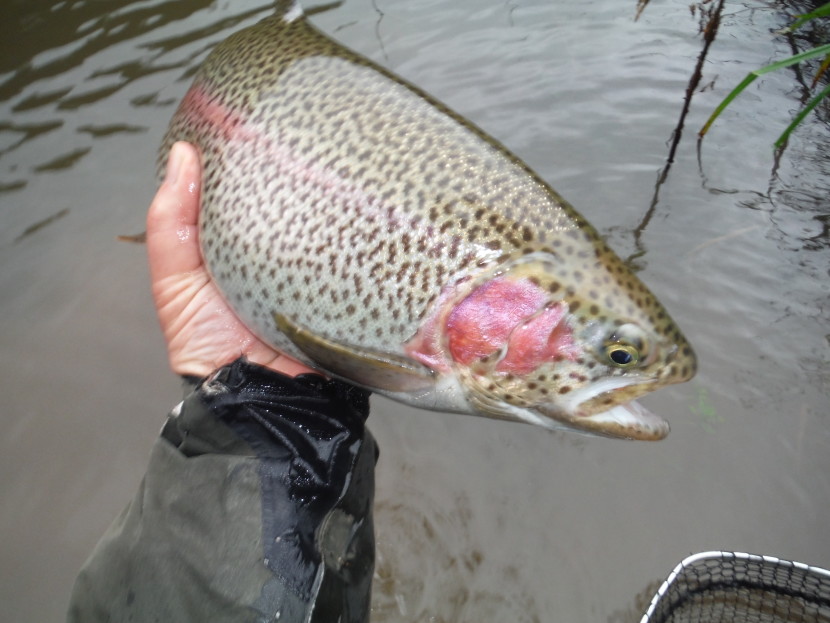 Food for an otter
Food for an otter 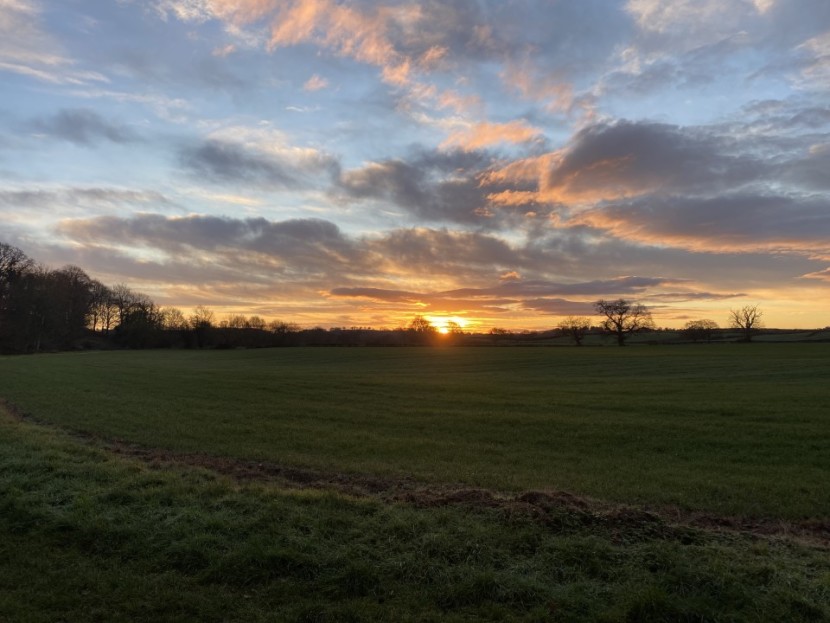 Winter morning - ME from Ireland
Winter morning - ME from Ireland One evening this month Laurence Fox devoted a large part of his show on GB News to discussing fishing and its therapeutic benefits as defence against, in his case, the black dog of depression. For many urban dwellers fishing becomes a gateway to understanding the natural world. Fox also established a live link to Matt Hayes, snug in his fishing lodge by Norway’s River Gaula, who spoke equally eloquently on behalf of our beloved sport. We can all envy Matt and his family – for heaven sake, they have 4 kilometres of a world-famous salmon river to play with – but he reminded us that he started out as a Black Country boy fishing for sticklebacks in the local canals and reservoirs, since when he has had a chance to try almost every branch of the sport.
Both men had warm words for the wonderful Herefordshire Wye, but failed to understand why now, even when everybody including NRW accepts the damage being done to it by agricultural pollution, no significant action seems likely to be taken. There’s seemingly no passion about the subject of pollution amongst our political leaders complained Matt Hayes, and both men wondered why we are constantly being asked to change our lives to save the planet, but nobody is much troubled to save our local river. These are not new thoughts. 90 years ago the celebrated midland fly dresser Roger Woolley advised: “Help in every way you can all movements against pollution of our rivers, or soon there will be no fishing at all for us, or for those that follow us.”
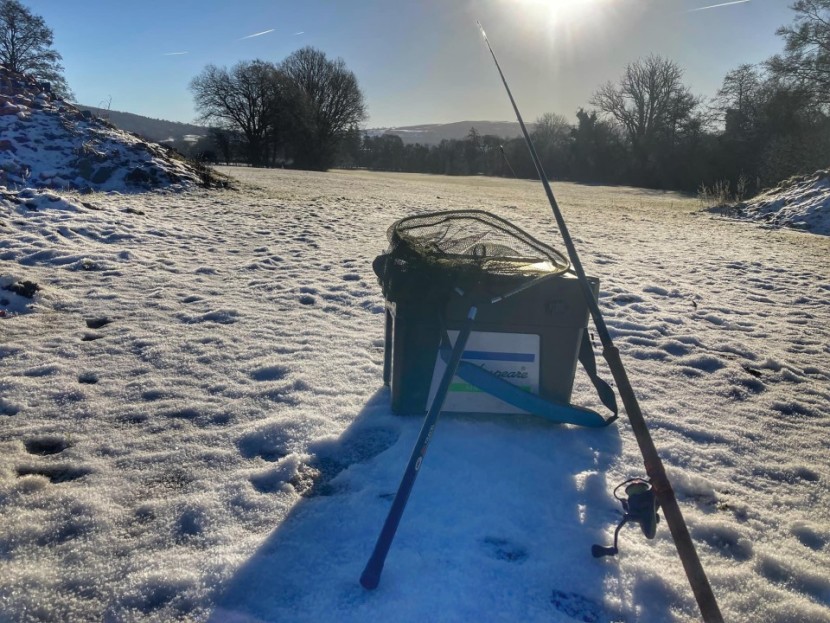 Trotting at Builth Wells - MH from Llandrindod Wells
Trotting at Builth Wells - MH from Llandrindod Wells 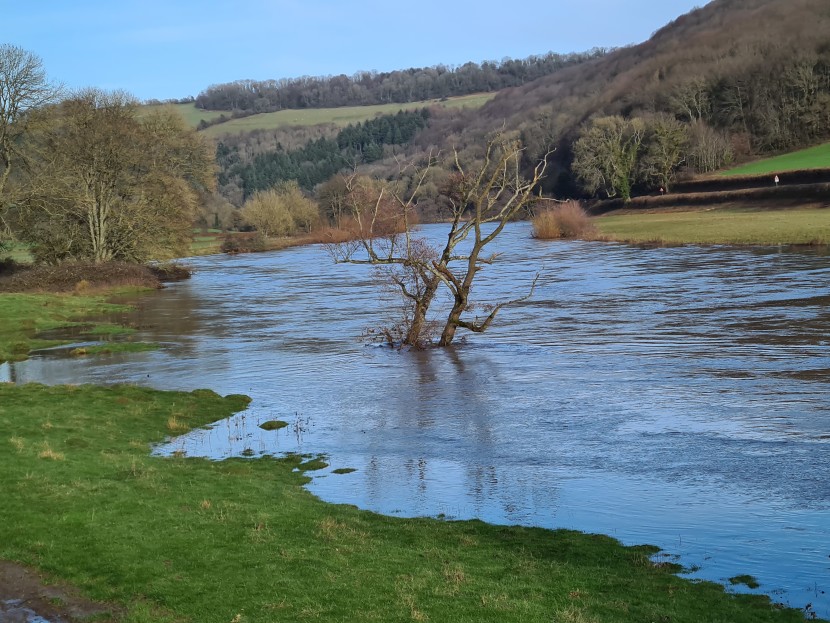 Lower Wye filling its valley
Lower Wye filling its valley In the December letter, I looked at what the Victorian writer and angling newspaper editor Francis Francis had to say on the subject of coarse fishing, which was a great deal. In the latter part of his Book on Angling he has a great deal more to say about trout and salmon, beginning with the following: “A good trout fisher will easily become an expert at salmon-fishing, but a very respectable practitioner with the salmon rod will often have all his schooling to do afresh, should he descend to trout-fishing…” Clearly Francis felt the need to demonstrate just a little “one-upmanship” on behalf of the trout fishers of his day.
From a modern perspective, the tackle he describes seems quite strange. A single handed trout rod according to Francis should be 11-13 feet, “according to the angler’s strength”. Personally he liked a double hander for trout and stuck to it longer than most. His usual rod was 14ft 6 inches made by Ogdens of Cheltenham and for sea trout he used a 15 foot weapon made by Carter of Pentonville. In his book we also read the first description of split cane, made by Aldred, although in this case three pieces of cane were glued together, not six. I cannot imagine what a cane rod with a near triangular cross-section would have been like to fish with. With his big rod he “…killed four fish with a large palmer fly at Alton during two evenings in the first season that I used it that together weighed twenty-two pounds, and the proprietor of the water was so pleased with it that he had one made up to the same pattern…the fish run large, even up to nine or ten pounds in his water…” I presume that this paradise would have been Alton by the Churnet in Staffordshire, rather than Alton by the source of the Wey in Hampshire. There were no 10 pounders in the upper Wey when I knew it even if a 14 foot rod could be waved over the diminutive stream!
 Previous owners
Previous owners  Natural flies
Natural flies Francis did not get on with the early silk lines, preferring a fly-line made of silk and horse hair mixed. He does emphasize the importance of matching the line to the rod and suggests asking the tackle dealer to do it. The days of matching AFTM numbers for fly-lines and rods were far in the future. “A plain click winch is best” he claims and I wouldn’t disagree with that. On casting: “I consider 18 to 20 yards a very long throw with a single handed rod, and there is not an angler in a thousand that can throw it; while, of those who can throw it (properly), not one in a hundred can fish it….The great proportion of anglers use double the force that would be needed to cast a much longer and lighter line than they do cast…keep your elbow down near your side and make the top joint of the rod do its work.” This I think is also good advice for the present day. He wasn’t above showing off a bit, both with the rod and the pen, describing showing a keeper on the Lathkill “how it’s done,” and going into some quite convoluted Greek roots of Latin words supposedly for the benefit of readers. The “eye” of a stream (meaning just to the side of the inflow) is always good he tells us and describes fishing the Avon with a dry fly introduced at the heads of pools, taking five in one morning, “…and they were all extra good fish…It was a bit of fishing which I have always felt extra proud of.” He describes, too, fishing in Hampshire on the Earl of Portsmouth’s water, which must surely be the Bourne Rivulet made famous half a century later by Harry Plunkett Greene in Where the Bright Waters Meet. Yellow may duns were apparently hatching on that day.
Francis usually fished teams of flies and stated simply: “There are two ways of fishing…with the dry fly and with the wet fly.” However, there is already description in his book of early experiments with nymphs, and this long before the famous conflict between supporters of Halford and Skues. If what follows now isn’t fishing with a weighted nymph, I don’t know what is:
“I may state here, that in deep pools or mill heads, no plan is so killing as to suffer the fly to sink to the bottom, and then to work it with short, sharp, shoots up to the surface…in calm or hot water it is a capital dodge. If there is too much stream, bite a shot on the gut at the head of the fly, and if it savours not too much of taking a mean advantage, put a gentle on the hook…if the proprietor of the water does not look upon it as poaching.”
 Grubs and beetles plus Teme Grasshopper
Grubs and beetles plus Teme Grasshopper  Knots
Knots  Minnow tackle
Minnow tackle I think that Francis Francis was living rather dangerously when he suggested maggots as well as weight on trout fishermen’s fly hooks, even if he felt secure in his status as editor of The Field, and even if Welsh anglers were doing the same in pursuit of sea trout. I’m reminded of the unholy glee with which the former secretary of our Forest Syndicate, a retired County Court judge, told me many years ago the story of finding a fly lost in a tree by a certain well-known syndicate member: “Can you believe it, there was a maggot on the point, no doubt about it? And he was a magistrate too, respectable pillar of the community. I made sure that he knew that I knew. He couldn’t look me in the eye after that.” No doubt you could get black-balled from clubs for less. I’m almost surprised old Russell, who joined the majority long ago and whose ashes were spread on his favourite pool, didn’t offer this guilty syndicate member a loaded revolver.
Francis discusses night fishing briefly and the choice between imitation versus impressionism in fly patterns, this being a subject which still exercises many of us. He describes also a North/South divide, the North being represented by the writings of Stewart (then still living) and the South by the chalk stream specialists. Rather controversially he takes sides and states that the trout of south country streams were very much more fished over and therefore “wiser” than those of the North, where there was a possibility of using worms, minnows, etc, not permitted in the South. I wonder what New Zealand’s Bob Wyatt would make of the idea of “wiser” chalk stream trout? For that matter, I wonder what Mr Wyatt – who believes you can manage on half a dozen trout fly patterns while concentrating on presentation – would have to say about the enormous collection of fly patterns recommended by Francis Francis? We have a very different view today. As you will see later, Francis gives almost as many salmon patterns as he does trout flies, and in both cases some of his advice seems quite hard to follow. It is also slightly confusing to know when he is using the Allcock’s Redditch Scale of hook sizes, which has survived to this day, and another scale of his own recommendation for Limerick pattern hooks. Generally his trout flies seem to have been large, commonly the modern size 10. He had most of them tied by Hammonds of Winchester, but he gives full instructions for amateur dressers.
 Limerick hooks
Limerick hooks  River Tay
River Tay I suspect also that the trout fly hatches he refers to have changed over time. On the subject of the February red, he mentions Mr Ackers, who was then President of the Leintwardine club on the Teme. On the Wandle, now well buried in South London suburbs, he refers to what we call the large dark olive, but was then known as the blue dun. Patterns he recommends are the Cocktail, Early Dark Dun, Hare’s Ear, Blue and Olive Dun, Blue Drake, Hare’s P, Hare’s Fleck and Blue Upright. He remarks that the gravel bed “abounds on the Usk,” and strangely is much more enthusiastic about the cowdung fly than about any March Brown pattern. On the other hand he is very keen on the alder, “one of the best flies which comes upon the water.” I still see the natural brown cowdung fly, where it belongs on cowpats in the fields, but not so often on the water. Other Victorian anglers have extolled the virtues of the alder; personally, while I have seen natural alders taken and I have fished with a dry Alder pattern on occasion and also on still waters with the nymph, I wouldn’t call it a mainstay of my own spring fishing. He has this to say about what was known then as the pale evening dun: “It comes on thickly on some streams at dusk. On the Teme, for example, I have seen it heavily on. As it comes on at dusk it is difficult to see this fly on the surface, so delicate and imperceptible it is, and yet, to the angler’s annoyance, the trout will be rising heavily without his being able to discover at what.” John Goddard suggested this was quite localised and could be imitated like a pale watery, to which it is very similar. So today one might try a small Grey Duster, or a tiny Ducks Dun or perhaps a size 18 Grayling Steel Blue? Francis famously designed a general purpose fly of his own, the Francis Fly, and here is the dressing:
Hook: (He gives the Limerick scale of 7-12, but I presume a modern 10-14)
Body: Copper coloured peacock herl ribbed with copper/red silk
Hackle: Medium blue dun
Wings: Hackle points of grizzly blue cock
Otherwise, general purpose flies he recommends are Coachman, Hoflands Fancy, The Governor - “…a very useful fly on many waters, particularly in the metropolitan district, where its use is almost general,” Edmead for the midlands, Greenwell’s Glory – “…kills well on all Northern streams,” Grouse Hackle, Partridge Hackle, Soldier Palmer and all of Stewart’s flies. The idea of the Governor in the metropolitan district made me smile. It’s curious in modern times to imagine any artificial fly designed for use in London.
 Trout fly dressing
Trout fly dressing Francis Francis claims a wide experience of the natural lakes of Ireland, Scotland and Wales, for which he suggests the well-known Teal and Mallard series of wet flies and of course Golden Olive. Or more simply and personally: “I generally commence with a March Brown and a Soldier Palmer and seldom need to change.” There are some more specialised lists provided: six lake flies from the Rev. Ainslie for use in Scotland or any large waters, six more for Llyn Ogwen and other Welsh lakes and a dozen Irish ones from Haynes of Cork. On lakes of this kind he wisely suggests fishing towards the shore from the boat, in the region of inlet streams, under overhanging trees and around rocks and skerries. Of course he emphasizes the importance of skating the top dropper fly through the surface. “There are free-rising lakes,” he writes, “and there are sulky lakes. On sulky lakes, try a big fly with a split shot. And, by the way, be sure to put out your pipe completely when you stow it on your pocket.” That advice was the fruit of one particularly unfortunate experience when his trousers caught fire! He mentions blow lines and dapping, using cane rods up to 20 feet long.
Francis the editor was clearly rather conflicted about some of the other methods than purist fly-fishing, which he sensibly recognizes were longstanding local customs. If a method was the local custom, he would be reluctant to condemn it. “…the piscatorial mind has a strange way of looking at the word poaching. With many people, “poaching” means fishing in any other way than that favoured by the appellant.” That is certainly true today. He goes on to quote from Samuel Butler’s Hudibras about those who:
Compound sins they are inclined to
By damning those they have no mind to
Still, Francis clearly had a lot of problems with all bait fishing. Struggling to be diplomatic, deciding not to condemn the use of bait if it was the local custom seemed the obvious course. He thus goes on to give a lot of instructions about fishing creepers, beetles and worms, particularly in the North. On worming brooks, which he began as a boy on becks in Cornwall, he recommends a 13 or 14ft rod and confesses: “This was my first experience, my first angling love, and will be my last.”
He was comfortable enough with the spinning rod and for the great trout of the Thames weirs recommended one of 14 or 15ft bamboo, less stiff than that for pike. He would mount a small dace or a small bleak upon a spinning flight (about which he gave much detail) and did not so much care for paternostering or float fishing live bait. These big trout were well educated fish he tells us, so many of them had been hooked and lost. He also was aware of competition, particularly from professional fishermen who perhaps naturally enough kept their knowledge close except for those who employed them. Perseverance was necessary and a week of fishing might be necessary to get a run from a good one, starting early in the morning before the boat traffic. Still he had been successful with a 12 ¼ pounds Thames trout which was set up in a case by the famous taxidermist Cooper.
Trout spinning on lakes for Francis Francis was a matter of trolling heavy gear behind a steadily rowed boat. On smaller rivers: “…do not do it if it be a fair fly-fishing stream…you spoil the sport, probably of many others who may be fly-fishing after you.” And on parr tail fishing, quite common on Victorian trout streams: “Take particular care that the water bailiff does not note your operations, or you will probably be fined for killing salmon fry.”
In an uncharacteristically short section he speaks a lot of good sense about grayling, which: “…should not be fished for till August; they are not worth eating before that, and not very good then. A September fish is better than an August fish, October better than September, and November best of all.” He knew that a glimpse of sunshine would be helpful during winter fishing and that, soft mouthed as they are, grayling can easily be lost in play. Despite his earlier encouragement to add split shot when necessary he has much to say about the famous or perhaps notorious Leintwardine Grasshopper, which resulted in huge bags only on Severn tributaries and which he considered to be poaching! (For those who don’t know, the Grasshopper was clearly an early type of weighted nymph, to be dropped into deep holes full of grayling). Francis Francis had a soft spot for grayling, but not so editor Sir Herbert Maxwell who steps in at this point declaring they should not be allowed in trout streams.
 Big rivers of Scotland
Big rivers of Scotland  Chalk stream and white trout river
Chalk stream and white trout river Francis doesn’t have much to contribute about sea trout which he deals with together with Salmo eriox or bull trout. There was of course much confusion in his time about what we know today as different variations of brown trout. However, he was a very keen and well- travelled salmon fisher and so surely a good source. On the subject of selecting salmon rods, Francis Francis advises beginners not to be over-ambitious: “For a man of short stature 16ft 6ins to 17ft 6ins, medium stature 17ft to 18ft, strong and tall 18ft 6ins to 20 or 21ft.” Today we weigh our carbon salmon rods in ounces; these weapons of greenheart or hickory, whether spliced or ferruled, weighed 3 pounds or more. They were mostly used for overhead casting, although Francis does describe the single Spey and makes the point that you have to wade in a few yards to Spey cast easily.
 Salmon fly dressing
Salmon fly dressing  Victorian salmon flies 2, Beauly Snow Fly, Black Dog, Purple King
Victorian salmon flies 2, Beauly Snow Fly, Black Dog, Purple King He was certainly a collector of salmon flies and makes fun of the “six fly men.” I guess he would make fun of me, because I could certainly manage with six patterns for salmon and I also believe with Ally Gowans that there is no point in having more than three colours in a salmon fly. Thus I am not sure I get much practical value as an angler from the many pages he devotes to Victorian salmon flies, but it certainly makes a fascinating collection with colour plates to match. From Francis we hear about general patterns like Doctor, Silver Doctor, Black and Blue Rangers, Butcher, Childers, Black and Teal, Durham Ranger, Jock Scott, White Wing, White Tip and Topping (these three were later used by Chaytor), Kate, Blue Doctor, Black and Yellow, Golden Mallard and Dusty Miller.
 Victorian salmon flies 1, Jock Scott, Lee Blue, Butcher, Popham, Claret Jay, Dun Wing
Victorian salmon flies 1, Jock Scott, Lee Blue, Butcher, Popham, Claret Jay, Dun Wing  Victorian salmon flies 3, Gordon, Sir Herbert, Wilkinson, Mar Lodge
Victorian salmon flies 3, Gordon, Sir Herbert, Wilkinson, Mar Lodge  Victorian salmon flies 4, Brown Ackroyd, Tartan, Snow Fly, Shannon
Victorian salmon flies 4, Brown Ackroyd, Tartan, Snow Fly, Shannon  Victorian salmon flies 5, Black Ranger, Highlander, Thunder and Lightning, Black and Teal
Victorian salmon flies 5, Black Ranger, Highlander, Thunder and Lightning, Black and Teal  Victorian salmon flies 6, Dusty Miller, Francis Favourite, Blue Doctor, Bittern
Victorian salmon flies 6, Dusty Miller, Francis Favourite, Blue Doctor, Bittern  Gaffing salmon
Gaffing salmon These flies he obtained from Farlows in London, and also the famous Jamie Wright of Sprouston. He also has a collection of local flies still in vogue, which he obtained by correspondence. These include the four-winged Dun Turkey for the Stinchar, a river with nets then regulated by Lord Stair, “a keen fisher.” The red and black Stinchar Stoat would be my modern choice for that peat-stained river. There is the Denison, named after Speaker Denison’s Rule, and for the Welsh Wye in spring he recommends something called the Dhoon Fly which was originally a mahseer fly used in the Himalayas. It was also sometimes known on the Wye as the Canary – but beware, confusingly there is another Canary or Goldfinch which was used on the Scottish Awe. Here is the dressing for the Dhoon in case you would like to have a try at it:
Tag: Gold tinsel and ruby floss; Tail: Golden pheasant topping; Butt: Black ostrich herl; Body: In four joints of bright yellow floss. At every joint a large wad of bright yellow wool is tied in for a hackle and left long and bushy (in the two lower joints it is yellow wool, the upper two of yellow/orange pig’s wool, very long and bushy); Rib: Gold twist; Hackle at shoulder: Orange over yellow; Wing: Two big slips of bright orange swan feather, two good long kingfisher or chatterer at cheek; Head: Black
Compared to that complication, I have rather more faith in the look of a dull fly called the Bittern which he got from the keeper at Builth Wells. However, today something other than bittern feather would have to be substituted as hackle. For the Usk he came up with the Llanover, provided in fact by Lord Llanover himself. Here is the recipe and good luck also with this one:
Tag, silver twist; tail, a topping; body is a Namsen body (body roughish, two turns of yellow pig’s wool merged into deep orange, and that into medium red claret, and that into bright medium or inclining to darkish blue, the upper part of the claret and blue tied in longish for picking out); hackle at shoulder, a dirty smudgy coch y bondu hackle; wing, mixed brown (mottled) turkey, bastard bustard, pintail, blue, yellow and claret swan (the first most plentiful), a topping over all, blue macaw ribs; and peacock herl head.
xxx.JPG?w=830) The Bittern, Builth Wells (Francis Francis from local keeper)xxx
The Bittern, Builth Wells (Francis Francis from local keeper)xxx  Playing salmon
Playing salmon You could get the Llanover and others suitable for the Usk from Martins of Brecon or Peake of Abergavenny, “…a well-known maker and first-rate practical authority.”
Francis also gives a lot of sea trout patterns, following the Irish colourful salmon fly style, but generally rather smaller. Interestingly the present era has a tendency to provide larger sea trout patterns and they are quite different from the salmon flies. Francis lived in a period when sea trout fishing was generally regarded as a scaled down version of salmon fishing. This was a mistake, I think, but surely a common mistake at the time. In short, knowledge of sea trout was then rather limited.
Francis bought most of his flies, but he devotes a lot of space at the end of his book to the art of fly dressing, remarking that amateurs use a vice, but professionals use their fingers. He recommends the Holtzappfel vice, from Cockspur Street, costing 3 or 4 pounds but “splendidly worth it.” He tells us that professionals, using their hands only, engaged in mass production, not tying fly by fly as we do, but two, three or four dozen at a time of bodies, then the hackles, then the wings etc. He gives full details of tying techniques, particularly for the big salmon flies. There is much discussion of Blacker’s book Fly Making, Angling and Dying. Although Blacker’s flies were admitted to be very neat, Francis criticises his tying techniques. (Just to make the situation more complicated, editor Sir Herbert Maxwell chips in with disagreements from the suggestions of Francis). The book ends with some technical advice about hooks, baits, dying gut and dressing lines. In those days you had to make your own varnishes, waxes and dressings.
Finally, proving himself absolutely up to date for his time and also that there is nothing much new about destination fishing, I would like to remember Francis Francis making a protest that Norway in his day was not what it was due to angling pressure and that there was no cheap fishing now to be had there. Some of the old aristocrats hold out against tourism he complained (which must have been a dig at the then Duke of Westminster) and “…you cannot be whirled by rail to the Arctic Circle in 24 hours.” Still, salmon on ice could now be sent from Norway to England he notes, and that sadly “…there are fifty salmon fishers now for one of twenty years ago.”
Plus ca change…
Amidst the ongoing chaos of wartime prices, inflation and especially strikes into which our present political leaders seem to have walked us, and while almost everybody claims to be struggling financially, how about considering a few everyday stories of working folk, including neighbours and friends of ours:
The Nurse’s story: There is still that tendency for the British public to regard nurses as angels, which surely goes back to the profession’s founding legend and the image we were shown in school: Florence Nightingale, “the lady with the lamp,” walking through the darkness of Scutari military hospital where soldiers were dying of wounds and disease during the Crimean War. But a 19% rise for nurses as demanded? Somehow I don’t think so, not for all nurses, any more than I think throwing even more money at the NHS will make a failing organisation into an efficient one. I am no health professional, but everybody else seems to have a view, so as a tax payer I’m developing mine. I remember on Thursday evenings not so long ago banging a kettle on the door step in support of the NHS. I don’t feel inclined to do it now. The NHS was in trouble even before it became obsessed with Covid and suspended normal services. Perhaps the worst mistake was a changed contract for general practitioners, which permitted them to reduce health centre services to 9 to 5 office hours. Worse than that, on the arrival of Covid, many of them locked their doors. If you can’t get an appointment with a doctor and you really feel ill, your next port of call will be A&E. An ambulance driver told me a while ago that we are getting to a situation where emergency paramedics are being left to carry out the initial triage service for every kind of complaint. Speaking from personal experience, what do you do when you have a very sick elderly relative whose doctor refuses to see her? At the beginning of Covid I was told by her health centre: “If you think it is bad enough, call an ambulance for her.” My 90 year old aunt, still living alone and weakened by a respiratory infection, decided herself in that case that an ambulance or a trip to A&E at the county hospital wasn’t justified. Thankfully a simple course of antibiotics resolved that one, but without a doctor it took a further week to get it prescribed and then it only happened because a neighbour who knew the practice manager became concerned about her condition.
You would think that tax-payers, those of us who pay for the services we aren’t getting, would by now be much more incensed about the situation than we are. Politicians love to boast about how much money they spend on the NHS, but we want to see our money used for sensible and solid benefits, not incompetent wastage by a distinctly overpaid and woke management structure. The midlands health trust which recently advertised a position as something called a “lived experience director” at £115,000 pa seemed at first to be an extreme and isolated example – or maybe not? I looked up the full description for this job – sorry, role - and it is utter nonsense. Which ninny in management dreamed up such a job to be paid for with our money? And shouldn’t they lose their own? Unfortunately, when you look around the health trusts you find a lot more of the same sort of nonsense: an activity which is best described as defining a non-existent problem and inventing a job to deal with it. Health Minister Steve Barclay himself has acknowledged that our incredibly expensive NHS suffers from a top heavy structure with too many overpaid senior managers looking for something to do. Our NHS needs to be stripped down and rebuilt.
Leaving incompetent management aside, there is a case for serious pay claims put forward by active clinical staff along with porters, ambulance paramedics etc. But let’s look at the nurses’ claim for a moment. There is a complicated pay scale for nurses, involving lots of different grades. Along with the wild stories about food banks and desperate nurses sleeping on friend’s couches, we are told the average nurse earns around 33,000 pa. Some earn much higher salaries. These pay rates are for nurses with degrees. We are assured that today degrees rather than hands-on training are really necessary for nurses, although I have my doubts. Let’s instead consider the lower end of the scale, the auxiliary nurses. These are the ones who deal with the unpleasant stuff: the bed-pans, blanket washes etc. They get around 19,000 pa to start, let’s say 11 or 12 pounds per hour. I certainly agree that these people have a good case for a rise.
The Carer’s Story: But now consider another group of people who do almost exactly the same job as the auxiliary nurses, but either in a private care home or domestic setting. These are the care workers who look after the elderly or disabled in their homes all over the UK. Many are recruited from rural areas like mine. Some have extra qualifications or skills, such as those needed to deal with disabled children or clients with learning difficulties; others do not. Their job involves a good measure of wiping up bodily fluids and sometimes dealing with aggressive or inappropriate sexual behaviour. For the most part they earn the basic minimum wage or 9.50 per hour, (due to change to 10.42 in April 2023), but rarely much more. Often when travelling from client to client it is very difficult for them to put a significant number of chargeable hours together. Consider also that, unlike the auxiliary nurses in hospitals and health centres, most of these care workers are on zero hours contracts, and mostly without pensions, and sickness benefits. Almost without exception carers are not unionised and they are certainly not on strike. Maybe they should be? Care workers did not feel particularly valued by society during the Covid period. I know one who in the early days of the first vaccine roll-out, when nurses and other NHS workers were being vaccinated as a priority, contacted her local health centre. She sensibly pointed out that she and her colleagues were visiting a dozen elderly and presumably vulnerable people in their homes on a daily basis and so it might perhaps be a good idea to give them early vaccinations? “Don’t try to jump the queue,” she was told. Later, on the other hand, those care workers reluctant to be vaccinated as instructed lost their jobs. It’s a hard way to make a living and it’s no wonder that, these days, so many domestic care workers are finding it preferable to run around delivering Amazon parcels or have taken to working a supermarket till.
There is a reason for linking and comparing these two groups. Those who should know tell me that the biggest problem the NHS faces is that of the bed-blockers - an ageing population who get into trouble at home, perhaps with something as simple as a fall, and via A&E end up in a hospital ward. In this age of a highly mobile younger population, the family rarely step forward to help at this stage. In Southern and Eastern Europe where family units are closer, the young are more likely to take care of the old, but not here. Nobody wants to call adult children who decline to take on care of elderly parents selfish, but the reality in this country is that the state is usually left to own the problem. For some reason local cottage hospitals, which during a patient’s convalescence used to offer a reduced but reliable standard of medical care, a very useful service, have mostly been closed. So all too often and certainly unnecessarily, the elderly patient remains in bed in a main central hospital while staff struggle with social services to put together a suitable care package at home. It’s getting more and more and more difficult to plan a care package, mainly because of the lack of carers prepared to do what is a very poorly paid job. Perhaps I am being naïve – and I would happily hear from anybody else with a view on this subject if I am getting this wrong – but it seems to me that if a poorly managed health service is to be re-organised, it should be enlarged to include the network of domestic carers as well as auxiliary nurses. A friend in the NHS tells me that bed-blocking is the biggest problem that they have and that the whole system would probably work without a penny more being spent on central hospitals, doctors, nurses or paramedics, if only patients could be moved on from hospital beds when they no longer need them. He feels that domestic care should be taken in-house as an NHS function in order to ease the exit from blocked main hospital beds. Health and social care should be interlinked and managed as a single organisation. I’m thinking that if any wage increases are being considered, it is these two groups of people, auxiliary nurses and carers, the ones who do the real hard work, which should be prioritised.
The Migrants’ Story: Which links me to the tale of a couple of good friends of ours. A former migrant from North Bosnia, and let’s call him Andy, has been in this country (legally) for more than 20 years. He met and married a very nice girl from Malawi, also here legally through the immigration system, and they have two young children. Andy has a talent for general building work, so over the years we have known him he has bought a series of run-down cottages around the Forest area, restored them while living in them and sold them on at a small profit. To supplement that he also drives a truck for one of the big supermarkets, delivering food from a logistics centre near Bristol to Truro. Cornwall and back with a heavy goods vehicle makes for a hard day’s work, but Andy was never afraid of hard work. His wife – and let’s call her Polly – manages to smile while looking after two small children in the sort of building site environment Andy creates at home (he is quite prepared to take the roof off during his restoration efforts), plus she works night shifts as a care assistant in an old people’s home, and is also studying for a commercial qualification. That’s what life is like for many immigrants to this country. It isn’t an easy ride here in the UK; migrants soon learn that if you want to make it you have to earn it.
Those who remain at home in the sending countries tend to imagine that anybody who makes it to more developed parts of the world becomes a millionaire without effort and relatives are very ready to milk this theory. During school holidays my brother-in-law with his wife and sons used to make an annual trip from Sweden down to Mostar to visit their surviving parents and the rest of the family. That’s quite a drive to make in mid-summer weather to what was known as the hottest town in former Yugoslavia. Once arrived, there were plenty of calls to be made on my brother-in-law’s time and purse, from the plumbing needing to be fixed in somebody’s flat to help with a nephew’s broken car. He seemed to be ever so popular. There would be a sort of party of admiring relatives going on every day in the apartment and every time they sent one of the kids out for more beer and snacks, all eyes would naturally turn to my brother-in-law to shell out for it. When he got home to his factory job in Sweden, he used to have to take out a loan to keep his own family going for the next couple of months until pay cheques caught up.
Returning to Andy and his wife, Polly’s sister with her husband and children came from Malawi to visit over this Christmas holiday. The sister works in an insurance company, and her husband works in a bank, so I suppose you could call them Malawian middle class. Before collecting them from Heathrow, Andy was grateful that he had just received a payment for his truck driving, because his old and rather thirsty diesel car cost more than 100 pounds to fill up. Once back in the Forest, Polly’s sister and brother-in-law pronounced themselves exhausted by the flight and headed off for bed, leaving their children to Polly, who had only just come off night shift looking after old people at the care home. One last thing before retiring: they handed over a list of dietary requirements (no egg white etc) to be passed on to the cook. The cook? Andy and Polly received the list, watched the visitors climb the stairs of the cottage and stared at each other in amazement.
It turned out that the Malawi household of Polly’s sister includes a cook, a cleaner and a nanny, which in that economy are paid for with very little more than bed and board. Without wages, that sounds almost like slavery, the sort of servitude I remember in households in India and Sri Lanka back in the day. Those virtue signallers in this country claiming to be so interested and apologetic about the subject of slavery, historic or modern, might take a look at Africa, Asia and especially the Middle East today if they want to inform themselves.
It’s a funny old world, isn’t it?
Oliver Burch